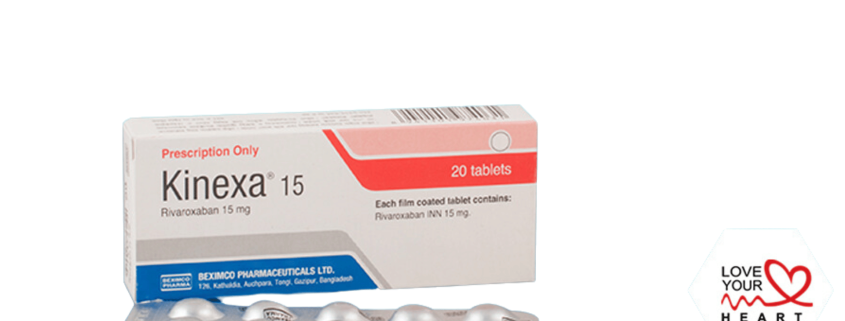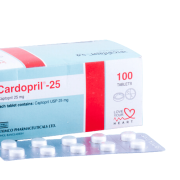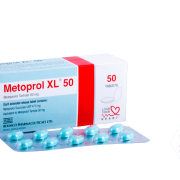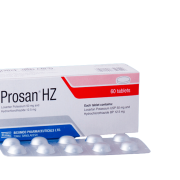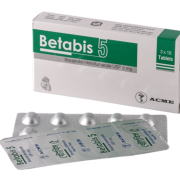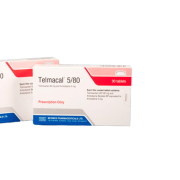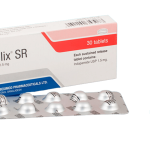Kinexa
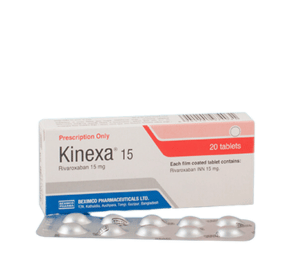
Generic Name: Rivaroxaban
Dosage Form: Tablet
TG Name: Cardiovascular
1. What is Kinexa®?
Kinexa® is preparation of Rivaroxaban, which is an anticoagulant and the first orally active direct factor Xa inhibitor.
2. How Kinexa® works in our body?
Inhibition of factor Xa interrupts the intrinsic and extrinsic pathway of the blood coagulation cascade, inhibits thrombin formation. Rivaroxaban does not inhibit thrombin (activated factor II) and no effects on platelets have been demonstrated.
3. What is the indication of Kinexa®?
Rivaroxaban is indicated for the prevention of venous thromboembolic events (VTE) in patients who have undergone total hips and knee replacement surgery; prevention of stroke and systemic embolism in patients with nonvalvular atrial fibrillation; treatment of deep vein thrombosis (DVT) and pulmonary embolism (PE); to reduce risk of recurrent DVT and/or PE.
Rivaroxaban is also indicated, in combination with aspirin, for reducing the risk of major cardiovascular events in patients with chronic coronary artery disease or peripheral artery disease.
4. What are the dosage & administration of Kinexa®?
Nonvalvular Atrial Fibrillation:
For patients with CrCl >50 mL/min: 20 mg orally, once daily with the evening meal.
For patients with CrCl ≤50 mL/min: 15 mg orally, once daily with the evening meal.
Treatment of DVT and/or PE: 15 mg orally twice daily with food for the first 21 days followed by 20 mg orally once daily with food for the remaining treatment.
Reduction in the Risk of Recurrence of DVT and/or PE in patients at continued risk for DVT and/or PE: 10 mg once daily with or without food, after at least 6 months of standard anticoagulant treatment.
Prophylaxis of DVT Following Hip or Knee Replacement Surgery: 10 mg orally once daily with or without food.
Prophylaxis of VTE in Acutely Ill Medical Patients at Risk for Thromboembolic Complications Not at High Risk of Bleeding: 10 mg once daily, with or without food, in hospital and after hospital discharge for a total recommended duration of 31 to 39 days.
Reduction of Risk of Major Cardiovascular Events (CV Death, MI, and Stroke) in chronic CAD or PAD: 2.5 mg orally twice daily, with or without food, in combination with aspirin (75-100 mg) once daily.
5. What are the contraindications of Kinexa®?
Rivaroxaban is contraindicated in patients with active pathological bleeding and severe hypersensitivity reaction to Rivaroxaban (e.g., anaphylactic reactions).
Warnings and Precautions
Risk of Bleeding: Rivaroxaban can cause serious and fatal bleeding. Promptly evaluate signs and symptoms of blood loss and to reverse the anti-factor Xa activity by using antidote with the suggestion of physicians.
Patients with Renal Impairment: Avoid or adjust dose based on CrCl and recommendation by the physician.
Patients with Hepatic Impairment: No clinical data are available for patients with severe hepatic impairment. Avoid use of Rivaroxaban in patients with moderate (Child-Pugh B) and severe (Child-Pugh C) hepatic impairment or with any hepatic disease associated with coagulopathy since drug exposure and bleeding risk may be increased.
Use with P-gp and Strong CYP3A Inhibitors or Inducers: Avoid concomitant use of Rivaroxaban with known combined P-gp and strong CYP3A inhibitors. Avoid concomitant use of Rivaroxaban with drugs that are known combined P-gp and strong CYP3A inducers.
Patients with Prosthetic Heart Valves: The safety and efficacy of Rivaroxaban have not been studied in patients with prosthetic heart valves. Therefore, use Rivaroxaban is not recommended in these patients.
Acute PE in Hemodynamically Unstable Patients or Patients Who Require Thrombolysis or Pulmonary Embolectomy: Initiation of Rivaroxaban is not recommended acutely as an alternative to unfractionated heparin in patients with pulmonary embolism who present with hemodynamic instability or who may receive thrombolysis or pulmonary embolectomy.
6. What are the adverse effects of Kinexa®?
The most common adverse reaction is bleeding. Increased risk of stroke after discontinuation in nonvalvular atrial fibrillation.
7. What would be the storage condition of Kinexa®?
Keep in a dry place & store below 30° C. Protect from light & keep out of the reach

